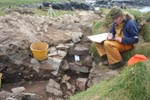Archaeologists reveal bloodier times for the Western Isles
Published: 15 August 2005
University of Glasgow archaeologists find evidence of a Medieval fortified settlement on a sea stack in Western Isles
Archaeologists at the University of Glasgow have made the dramatic discovery of a Medieval fortified settlement on a sea stack on the West Isles, revealing evidence of bloodier times for the site's history.
Dn istean is an inter-tidal sea stack on the north-east coast of the Isle of Lewis in the Western Isles of Scotland. Rising out of the cold waters of the Atlantic, this natural fortification is thought to have been the stronghold of the Clan Morrison during the late Medieval period (between 400 and 800 years ago).
Rachel Barrowman and her team of archaeologists from the University began digging onto the site to discover a square tower buried beneath a mound of rubble. Situated on the highest point of the stack the tower looks out across the Minch, the rough waters between the islands and mainland Scotland.
"The square tower was probably a lookout, defending the settlement on the stack," explains Rachel Barrowman. "Excavations have begun to uncover evidence for the bloodier episodes in the site's history, including finds of musket balls, and a defensive wall around the perimeter of the island."
"Previously the only access to the site was at low tide up a steep and slippery cliff, but now the stack can be accessed by a footbridge. We have found evidence of a gatehouse and other small buildings defending the entrance to the stack. Two of the buildings have been excavated. Each has a central peat hearth on the floor of the building and is built from low stone and turf banks."
Historically and archaeologically the Western Isles in the Medieval period differed from mainland Scotland, being culturally Scandinavian and politically part of Norway during the period c AD 800 to c AD 1300. With the demise of the Norse political control of the Hebrides in the 13th century, powerful competing clans emerged. The local traditions and stories relating to Dn istean, and the rival clans of Morrison and Macaulay in particular, emerge from this volatile and often violent period in Lewis' history.
"The results from this first short season of excavation have been very promising and have confirmed the archaeological potential of the site," explains Rachel Barrowman. "Further investigations are currently underway for the next six weeks, and a series of seminars will be held this winter in Ness, to provide a chance for all the specialists on the project to meet up and discuss the first year's results."
Media Relations Office (media@gla.ac.uk)
For fuller details please contact the University Press Office on 0141 330-3535, or Rachel Barrowman on 07776 491557.
The D?n ?istean Archaeology Project (DEAP) is a multi-disciplinary field project funded by the Heritage Lottery Fund (HLF), Historic Scotland, the Clan Morrison Society, Comunn Eachdraidh Nis and the Comhairle nan Eilean Siar, with contributions from the University of Glasgow. More information can be viewed at www.duneistean.org.
First published: 15 August 2005
<< August


